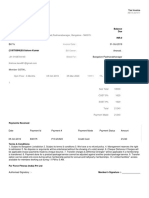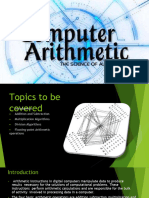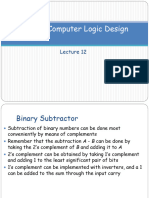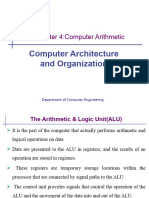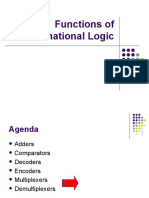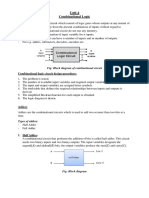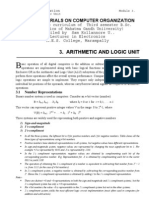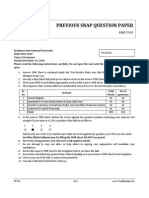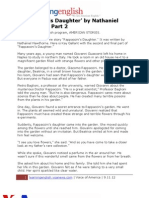Unit-3.2 Coa
Unit-3.2 Coa
Uploaded by
raghudesai951Copyright:
Available Formats
Unit-3.2 Coa
Unit-3.2 Coa
Uploaded by
raghudesai951Original Title
Copyright
Available Formats
Share this document
Did you find this document useful?
Is this content inappropriate?
Copyright:
Available Formats
Unit-3.2 Coa
Unit-3.2 Coa
Uploaded by
raghudesai951Copyright:
Available Formats
Computer Organization UNIT-I
3. Other alphanumeric codes:
The ASCII code is the standard code commonly used for the transmission of binary information.
Each character is represented by a 7-bit code and usually an eighth bit is inserted for parity. The
code consists of 128 characters.
Another alphanumeric code used in IBM equipment is the EBCDIC (Extended BCD
Interchange Code). It uses eight bits for each character (and a ninth bit for parity).
EBCDIC has the same character symbols as ASCII but the bit assignment to characters is
different.
Error Detection Codes:
Binary information transmitted through some form of communication medium is subject to
external noise that could change bits from 1 to 0, and vice versa.
An error detection code is a binary code that detects digital errors during transmission.
The detected errors cannot be corrected but their presence is indicated.
The most common error detection code used is the parity bit . A parity bit is an extra bit
included with a binary message to make the total number of 1's either odd or even.
A message of 3 bits and 2 possible parity bits is shown in the below Table.
The P(odd) bit is chosen to make the sum of 1's (in all four bits) odd .
The P(even) bit is chosen to make the sum of all 1's even. In either case, the sum is taken
over the message and the P bit.
Disadvantage (even-parity): It is having a bit combination of all 0's, while in the odd
parity there is always one bit (of the four bits that constitute the message and P) that is 1.
During transfer of information from one location to another, the parity bit is handled as follows.
Parity Generator:
At the sending end, the message (in our case 3-bits) is applied to a parity generator, where
the required parity bit is generated. The message, including the parity bit, is transmitted to
its destination.
Parity Checker:
At the receiving end, all the incoming bits (in our case, 4-bits) are applied to a parity
checker that checks the proper parity adopted (odd or even). An error is detected if the
checked parity does not conform to the adopted parity.
Parity generator and checker networks are logic circuits constructed with exclusive-OR functions.
Kallam Haranadhareddy Institute of Technology Page 24
Computer Organization UNIT-I
The exclusive- OR function of three or more variables is by definition an odd function.
An odd function is a logic function whose value is binary 1 if and only if, an odd number
of variables are equal to 1.
EX: consider a 3-bit message to be transmitted with an odd parity bit. At the sending end, the
odd parity bit is generated by a parity generator circuit.
The message and the odd-parity bit are transmitted to their destination where they are
applied to a parity checker. An error has occurred during transmission if the parity of the
four bits received is even, since the binary information transmitted was originally odd.
Computer Aritnmetic:
Introduction:
Arithmetic instructions in digital computers manipulate data to produce results necessary
for the solution of computational problems.
These instructions perform arithmetic calculations and are responsible for the bulk of
activity involved in processing data in a computer.
The four basic arithmetic operations are addition, subtraction, multiplication and division.
From these four bulk operations, it is possible to formulate other arithmetic functions and solve
scientific problems by means of numerical analysis methods.
An arithmetic processor is the part of a processor unit that executes arithmetic operations.
The data type assumed to reside in processor registers during the execution of an
arithmetic instruction is specified in the definition of the instruction. A:n arithmetic
instruction may specify binary or decimal data, and in each case the data may be in fixed-
point or floating-point form.
We must be thoroughly familiar with the sequence of steps to be followed in order to carry
out the operation and achieve a correct result. The solution to any problem that is stated by
a finite number of well-defined procedural steps is called an algorithm.
Usually, an algorithm will contain a number of procedural steps which are dependent on
results of previous steps. A convenient method for presenting algorithms is a flowchart.
Kallam Haranadhareddy Institute of Technology Page 25
Computer Organization UNIT-I
Addition and Subtraction:
As we have discussed, there are three ways of representing negative fixed-point binary
numbers: signed-magnitude, signed-1's complement, or signed-2's complement. Most
computers use the signed-2's complement representation when performing arithmetic
operations with integers.
i. Addition and Subtraction with Signed-Magnitude Data:
When the signed numbers are added or subtracted, we find that there are eight different
conditions to consider, depending on the sign of the numbers and the operation performed.
These conditions are listed in the first column of Table shown below.
Algorithm: (Addition with Signed-Magnitude Data)
i. When the signs of A and B are identical ,add the two magnitudes and attach the sign of
A to the result.
ii. When the signs of A and B are different, compare the magnitudes and subtract the
smaller number from the larger. Choose the sign of the result to be the same as A if A >
B or the complement of the sign of A if A < B.
iii. If the two magnitudes are equal, subtract B from A and make the sign of the result
positive.
Algorithm: (Subtraction with Signed-Magnitude Data)
i. When the signs of A and B are different, add the two magnitudes and attach the sign of
A to the result.
ii. When the signs of A and B are identical, compare the magnitudes and subtract the
smaller number from the larger. Choose the sign of the result to be the same as A if A >
B or the complement of the sign of A if A < B.
iii. If the two magnitudes are equal, subtract B from A and make the sign of the result
positive.
The two algorithms are similar except for the sign comparison. The procedure to be followed for
identical signs in the addition algorithm is the same as for different signs in the subtraction
algorithm, and vice versa.
Kallam Haranadhareddy Institute of Technology Page 26
Computer Organization UNIT-I
Hardware Implementation:
To implement the two arithmetic operations with hardware, it is first necessary that the two
numbers be stored in registers.
i. Let A and B be two registers that hold the magnitudes of the numbers, and A S and BS be
two flip-flops that hold the corresponding signs.
ii. The result of the operation may be transferred to a third register: however, a saving is
achieved if the result is transferred into A and AS. Thus A and AS together form an
accumulator register.
Consider now the hardware implementation of the algorithms above.
o First, a parallel-adder is needed to perform the microoperation A + B.
o Second, a comparator circuit is needed to establish if A > B, A = B, or A < B.
o Third, two parallel-subtractor circuits are needed to perform the microoperations A - B
and B - A. The sign relationship can be determined from an exclusive-OR gate with AS and
BS as inputs.
The below figure shows a block diagram of the hardware for implementing the addition and
subtraction operations. It consists of registers A and B and sign flip-flops AS and BS.
o Subtraction is done by adding A to the 2' s complement of B. The output carry is
transferred to flip-flop E, where it can be checked to determine the relative magnitudes of
the two numbers.
o The add-overflow flip-flop AVF holds the overflow bit when A and B are added.
Figure (i): Hardware for addition and subtraction with Signed-Magnitude Data
The complementer provides an output of B or the complement of B depending on the state of the
mode control M.
When M = 0, the output of B is transferred to the adder, the input carry is 0, and the output
of the adder is equal to the sum A + B.
When M= 1, the l's complement of B is applied to the adder, the input carry is 1, and output
This is equal to A plus the 2's complement of B, which is
equivalent to the subtraction A - B.
Kallam Haranadhareddy Institute of Technology Page 27
Computer Organization UNIT-I
Hardware Algorithm
Figure (j): Flowchart for add and subtract operations
ii. Addition and Subtraction with Signed-2's Complement Data
The register configuration for the hardware implementation is shown in the below
Figure(a). We name the A register AC (accumulator) and the B register BR. The leftmost
bit in AC and BR represent the sign bits of the numbers. The two sign bits are added or
subtracted together with the other bits in the complementer and parallel adder. The
overflow flip-flop V is set to 1 if there is an overflow. The output carry in this case is
discarded.
The algorithm for adding and subtracting two binary numbers in signed-2' s complement
representation is shown in the flowchart of Figure(b). The sum is obtained by adding the
contents of AC and BR (including their sign bits). The overflow bit V is set to 1 if the
exclusive-OR of the last two carries is 1, and it is cleared to 0 otherwise. The subtraction
operation is accomplished by adding the content of AC to the 2's complement of BR.
Comparing this algorithm with its signed-magnitude counterpart, we note that it is much
simpler to add and subtract numbers if negative numbers are maintained in signed-2' s
complement representation.
Kallam Haranadhareddy Institute of Technology Page 28
Computer Organization UNIT-I
Multiplication Algorithms:
Multiplication of two fixed-point binary numbers in signed-magnitude representation is done with
paper and pencil by a process of successive shift and adds operations. This process is best
illustrated with a numerical example.
The process of multiplication:
• It consists of looking at successive bits of the multiplier, least significant bit first.
• If the multiplier bit is a 1, the multiplicand is copied down; otherwise, zeros are copied
down.
• The numbers copied down in successive lines are shifted one position to the left from the
previous number.
• Finally, the numbers are added and their sum forms the product.
The sign of the product is determined from the signs of the multiplicand and multiplier. If they are
alike, the sign of the product is positive. If they are unlike, the sign of the product is negative.
Hardware Implementation for Signed-Magnitude Data
The registers A, B and other equipment are shown in Figure (a). The multiplier is stored in
the Q register and its sign in Qs. The sequence counter SC is initially set to a number equal
to the number of bits in the multiplier. The counter is decremented by 1 after forming each
partial product. When the content of the counter reaches zero, the product is formed and the
process stops.
Kallam Haranadhareddy Institute of Technology Page 29
Computer Organization UNIT-I
Figure(k): Hardware for multiply operation.
Initially, the multiplicand is in register B and the multiplier in Q, Their corresponding
signs are in Bs and Qs, respectively
The sum of A and B forms a partial product which is transferred to the EA register.
Both partial product and multiplier are shifted to the right. This shift will be denoted by the
statement shr EAQ to designate the right shift.
The least significant bit of A is shifted into the most significant position of Q, the bit from
E is shifted into the most significant position of A, and 0 is shifted into E. After the shift,
one bit of the partial product is shifted into Q, pushing the multiplier bits one position to
the right.
In this manner, the rightmost flip-flop in register Q, designated by Qn, will hold the bit of the
multiplier, which must be inspected next.
Hardware Algorithm:
Initially, the multiplicand is in B and the multiplier in Q. Their corresponding signs are in Bs
and Qs, respectively. The signs are compared, and both A and Q are set to correspond to the sign
of the product since a double-length product will be stored in registers A and Q. Registers A and E
are cleared and the sequence counter SC is set to a number equal to the number of bits of the
multiplier.
After the initialization, the low-order bit of the multiplier in Qn is tested.
i. If it is 1, the multiplicand in B is added to the present partial product in A .
ii. If it is 0 , nothing is done. Register EAQ is then shifted once to the right to form the
new partial product.
The sequence counter is decremented by 1 and its new value checked. If it is not equal to zero,
the process is repeated and a new partial product is formed. The process stops when SC = 0.
The final product is available in both A and Q, with A holding the most significant bits and Q
holding the least significant bits.
A flowchart of the hardware multiply algorithm is shown in the below figure (l).
Kallam Haranadhareddy Institute of Technology Page 30
Computer Organization UNIT-I
Figure(l): Flowchart for multiply operation.
Kallam Haranadhareddy Institute of Technology Page 31
Computer Organization UNIT-I
Figure (m): Numerical Example of multiplication
Booth Multiplication Algorithm:(multiplication of 2’s complement data):
Booth algorithm gives a procedure for multiplying binary integers in signed-2's complement
representation.
Booth algorithm requires examination of the multiplier bits and shifting of the partial product.
Prior to the shifting, the multiplicand may be added to the partial product, subtracted from the
partial product, or left unchanged according to the following rules:
1. The multiplicand is subtracted from the partial product upon encountering the first least
significant 1 in a string of 1's in the multiplier.
2. The multiplicand is added to the partial product upon encountering the first 0 (provided that
there was a previous 1) in a string of O's in the multiplier.
3. The partial product does not change when the multiplier bit is identical to the previous
multiplier bit.
Hardware implementation of Booth algorithm Multiplication:
Figure (n): Hardware for Booth Algorithm
The hardware implementation of Booth algorithm requires the register configuration shown in
figure (n). This is similar addition and subtraction hardware except that the sign bits are not
separated from the rest of the registers. To show this difference, we rename registers A, B, and Q,
as AC, BR, and QR, respectively. Qn designates the least significant bit of the multiplier in register
Kallam Haranadhareddy Institute of Technology Page 32
Computer Organization UNIT-I
QR. An extra flip-flop Qn+1, is appended to QR to facilitate a double bit inspection of the
multiplier. The flowchart for Booth algorithm is shown in Figure (o).
Hardware Algorithm for Booth Multiplication:
AC and the appended bit Qn+1 are initially cleared to 0 and the sequence counter SC is set to a
number n equal to the number of bits in the multiplier. The two bits of the multiplier in Q n and
Qn+1 are inspected.
i. If the two bits are equal to 10, it means that the first 1 in a string of 1's has been encountered.
This requires a subtraction of the multiplicand from the partial product in AC.
ii. If the two bits are equal to 01, it means that the first 0 in a string of 0's has been encountered.
This requires the addition of the multiplicand to the partial product in AC.
iii. When the two bits are equal, the partial product does not change.
iv. The next step is to shift right the partial product and the multiplier (including bit Q n+1). This
is an arithmetic shift right (ashr) operation which shifts AC and QR to the right and leaves
the sign bit in AC unchanged. The sequence counter is decremented and the computational
loop is repeated n times.
Figure (o): Booth Algorithm for multiplication of 2’s complement numbers
Kallam Haranadhareddy Institute of Technology Page 33
Computer Organization UNIT-I
Example: multiplication of ( - 9) x ( - 13) = + 117 is shown below. Note that the multiplier in QR
is negative and that the multiplicand in BR is also negative. The 10-bit product appears in AC and
QR and is positive.
Figure (p): Example of Multiplication with Booth Algorithm.
Division Algorithms:
Division of two fixed-point binary numbers in signed-magnitude representation is done
with paper and pencil by a process of successive compare, shift, and subtract operations.
The division process is illustrated by a numerical example in the below figure (q).
The divisor B consists of five bits and the dividend A consists of ten bits. The five most
significant bits of the dividend are compared with the divisor. Since the 5-bit number is
smaller than B, we try again by taking the sixth most significant bits of A and compare this
number with B. The 6-bit number is greater than B, so we place a 1 for the quotient bit. The
divisor is then shifted once to the right and subtracted from the dividend.
The difference is called a partial remainder because the division could have stopped here
to obtain a quotient of 1 and a remainder equal to the partial remainder. The process is
continued by comparing a partial remainder with the divisor.
• If the partial remainder is greater than or equal to the divisor, the quotient bit is equal to 1.
The divisor is then shifted right and subtracted from the partial remainder.
• If the partial remainder is smaller than the divisor, the quotient bit is 0 and no subtraction is
needed. The divisor is shifted once to the right in any case. Note that the result gives both a
quotient and a remainder.
Kallam Haranadhareddy Institute of Technology Page 34
Computer Organization UNIT-I
Figure (q): Example of Binary Division
Hardware Implementation for Signed-Magnitude Data:
The hardware for implementing the division operation is identical to that required for
multiplication.
The divisor is stored in the B register and the double-length dividend is stored in registers
A and Q. The dividend is shifted to the left and the divisor is subtracted by adding its 2's
complement value. The information about the relative magnitude is available in E.
If E = 1, it signifies that A≥B. A quotient bit 1 is inserted into Q, and the partial remainder
is shifted to the left to repeat the process.
If E = 0, it signifies that A < B so the quotient in Qn remains a 0. The value of B is then
added to restore the partial remainder in A to its previous value. The partial remainder is
shifted to the left and the process is repeated again until all five quotient bits are formed.
Note that while the partial remainder is shifted left, the quotient bits are shifted also and
after five shifts, the quotient is in Q and the final remainder is in A.
The sign of the quotient is determined from the signs of the dividend and the divisor. If the two
signs are alike, the sign o f the quotient is plus. If they are unalike, the sign is minus. The sign of
the remainder is the same as the sign of the dividend.
Divide Overflow
The division operation may result in a quotient with an overflow. This is not a problem
when working with paper and pencil but is critical when the operation is implemented with
hardware. This is because the length of registers is finite and will not hold a number that
exceeds the standard length.
To see this, consider a system that has 5-bit registers. We use one register to hold the
divisor and two registers to hold the dividend. From the example shown in the above, we
note that the quotient will consist of six bits if the five most significant bits of the dividend
constitute a number greater than the divisor. The quotient is to be stored in a standard 5-bit
register, so the overflow bit will require one more flip-flop for storing the sixth bit.
This divide-overflow condition must be avoided in normal computer operations because
the entire quotient will be too long for transfer into a memory unit that has words of
standard length, that is, the same as the length of registers.
This condition detection must be included in either the hardware or the software of the
computer, or in a combination of the two.
Kallam Haranadhareddy Institute of Technology Page 35
Computer Organization UNIT-I
When the dividend is twice as long as the divisor,
i. A divide-overflow condition occurs if the high-order half bits of the dividend constitute a
number greater than or equal to the divisor.
ii. A division by zero must be avoided. This occurs because any dividend will be greater than
or equal to a divisor which is equal to zero. Overflow condition is usually detected when a
special flip-flop is set. We will call it a divide-overflow flip-flop and label it DVF.
Hardware Algorithm:
1. The dividend is in A and Q and the divisor in B . The sign of the result is
transferred into Qs to be part of the quotient. A constant is set into the sequence counter SC to
specify the number of bits in the quotient.
2. A divide-overflow condition is tested by subtracting the divisor in B from half of
the bits of the dividend stored in A. If A ≥ B, the divide-overflow flip-flop DVF is set and the
operation is terminated prematurely. If A < B, no divide overflow occurs so the value of the
dividend is restored by adding B to A.
3. The division of the magnitudes starts by shifting the dividend in AQ to the left with
the high-order bit shifted into E. If the bit shifted into E is 1, we know that EA > B because EA
consists of a 1 followed by n-1 bits while B consists of only n -1 bits. In this case, B must be
subtracted from EA and 1 inserted into Qn for the quotient bit.
4. If the shift-left operation inserts a 0 into E, the divisor is subtracted by adding its 2's
complement value and the carry is transferred into E . If E = 1, it signifies that A ≥ B;
therefore, Qn is set to 1 . If E = 0, it signifies that A < B and the original number is restored by
adding B to A . In the latter case we leave a 0 in Qn.
This process is repeated again with registers EAQ. After n times, the quotient is
formed in register Q and the remainder is found in register A
Kallam Haranadhareddy Institute of Technology Page 36
Computer Organization UNIT-I
Figure (r ): Flowchart for Divide operation
Kallam Haranadhareddy Institute of Technology Page 37
Computer Organization UNIT-I
Figure (s): Example of Binary Division
Kallam Haranadhareddy Institute of Technology Page 38
You might also like
- Nicolas Roulin - The Psychology of Job Interviews-Taylor and Francis (2022)Document219 pagesNicolas Roulin - The Psychology of Job Interviews-Taylor and Francis (2022)Shakeel AnjumNo ratings yet
- Wonka Pure Imagination Pitch Your Own Chocolate Activity SheetDocument1 pageWonka Pure Imagination Pitch Your Own Chocolate Activity SheetSonia WatersNo ratings yet
- Kishore Gym Snap FitnessDocument1 pageKishore Gym Snap Fitnesssathish ananthaneni0% (1)
- Practical-1 AIM: Implement Register Transfer Operation in Logisim SimulatorDocument23 pagesPractical-1 AIM: Implement Register Transfer Operation in Logisim SimulatorDigvijay Sinh ChauhanNo ratings yet
- 10 4.1 Product StrategyDocument37 pages10 4.1 Product StrategyDurga Prasad Smart100% (1)
- Customer Satisfaction Towards Mobile Service ProvidersDocument52 pagesCustomer Satisfaction Towards Mobile Service ProvidersSaloni AnandNo ratings yet
- Co Unit-5Document20 pagesCo Unit-5moseslovely10commandsNo ratings yet
- Unit 5Document19 pagesUnit 5aayushadhikari9172No ratings yet
- Computer Arithmetic-1Document46 pagesComputer Arithmetic-1Bam NoiceNo ratings yet
- Complet Csa NotesDocument63 pagesComplet Csa NotespappusarvamNo ratings yet
- Unit2 2Document35 pagesUnit2 2npradeepjiNo ratings yet
- Unit-Ii Computer OrganizationDocument26 pagesUnit-Ii Computer Organizationmohamudsk007No ratings yet
- 5Document44 pages5misushil55No ratings yet
- Chapter 6 - CO - BIM - IIIDocument7 pagesChapter 6 - CO - BIM - IIIAnkit ShresthaNo ratings yet
- Co Notes Unit-3,4Document28 pagesCo Notes Unit-3,4iironman1267No ratings yet
- Unit 4Document13 pagesUnit 421embit027No ratings yet
- 4.Computer Arithmetic and MemoryDocument27 pages4.Computer Arithmetic and Memorycitecollege301No ratings yet
- Lec 12 CLDDocument21 pagesLec 12 CLDZahid AbbasNo ratings yet
- Unit - 5 Computer Arithmetic: 5.1 Addition and SubtractionDocument16 pagesUnit - 5 Computer Arithmetic: 5.1 Addition and SubtractionKeshav NaganathanNo ratings yet
- Computer Engineering Dushyant Rathod (210280107541) : Practical: - 4Document7 pagesComputer Engineering Dushyant Rathod (210280107541) : Practical: - 4Digvijay Sinh ChauhanNo ratings yet
- JNTUK R20 B Tech CSE 1-2 Computer Organization Unit 3 Reference 2 NotesDocument27 pagesJNTUK R20 B Tech CSE 1-2 Computer Organization Unit 3 Reference 2 NotessatyaNo ratings yet
- CO Unit 3-2Document15 pagesCO Unit 3-2Aravinder Reddy SuramNo ratings yet
- 5EC3-01: Computer Architecture: UNIT-2Document17 pages5EC3-01: Computer Architecture: UNIT-2Himanshi SainiNo ratings yet
- Chapter 04 Computer ArithmeticDocument40 pagesChapter 04 Computer Arithmeticanonsurf28No ratings yet
- AdderDocument1 pageAdderyojigip743No ratings yet
- COA Module 3 UpdatedDocument93 pagesCOA Module 3 UpdatedB G JEEVANNo ratings yet
- How Addition WorksDocument3 pagesHow Addition WorksetbalanseNo ratings yet
- CAO_CDT19 (1)Document6 pagesCAO_CDT19 (1)upadhyaashish07No ratings yet
- Unit 2 ALU Part 1Document7 pagesUnit 2 ALU Part 1ImranNo ratings yet
- AluDocument10 pagesAluAbhishek PatraNo ratings yet
- Comparators in Different Styles of Verilog Coding - 241007 - 081006Document12 pagesComparators in Different Styles of Verilog Coding - 241007 - 081006ratnesh yadavNo ratings yet
- ITec2036 Computer Architecture and Organization AssementDocument17 pagesITec2036 Computer Architecture and Organization Assementbamlakalemayew7No ratings yet
- Cs 404 Coa Unit II Computer ArithmeticDocument31 pagesCs 404 Coa Unit II Computer Arithmeticmanali100% (5)
- UntitledDocument63 pagesUntitled魏延任No ratings yet
- Unit III CAODocument39 pagesUnit III CAOmdmomin7517No ratings yet
- Register Transfer LanguageDocument17 pagesRegister Transfer LanguageGoldy BatraNo ratings yet
- AddersDocument36 pagesAddersaditipatil2404No ratings yet
- Arithmetic and Logic Unit (ALU) : ALU Is Responsible To Perform The Operation in The ComputerDocument13 pagesArithmetic and Logic Unit (ALU) : ALU Is Responsible To Perform The Operation in The ComputerSAFI ULLAH KHANNo ratings yet
- Module 3Document47 pagesModule 3beebeefathimabagum435No ratings yet
- Functions of Combinational LogicDocument52 pagesFunctions of Combinational LogicKetan SharmaNo ratings yet
- Arithmetic and Logic Unit (ALU) PDFDocument13 pagesArithmetic and Logic Unit (ALU) PDFnathulalusaNo ratings yet
- Unit - 3 of Computer ArchitectureDocument59 pagesUnit - 3 of Computer ArchitectureShweta mauryaNo ratings yet
- This Chapter Introduces Various Algorithms and Techniques To Perform Some Basic Arithmetic Operations Related To A ComputerDocument5 pagesThis Chapter Introduces Various Algorithms and Techniques To Perform Some Basic Arithmetic Operations Related To A ComputerarjuNo ratings yet
- DSD Mini Project Report1Document15 pagesDSD Mini Project Report1dineshNo ratings yet
- Coa 2Document10 pagesCoa 2pahujahimankNo ratings yet
- ALU unitDocument11 pagesALU unitmrhandsomboy998No ratings yet
- Cs Important Questions by UjjwalDocument19 pagesCs Important Questions by Ujjwalkumawatujjwal18No ratings yet
- Module-2 - Lecture 2: Alu - Signed Addition/SubtractionDocument44 pagesModule-2 - Lecture 2: Alu - Signed Addition/SubtractionWINORLOSENo ratings yet
- 10-Functions of Combinational LogicDocument13 pages10-Functions of Combinational Logicอภิเษก หงษ์วิทยากรNo ratings yet
- CH 7updated Unit 6 Computer ArithmeticDocument18 pagesCH 7updated Unit 6 Computer ArithmeticSujan TimalsinaNo ratings yet
- Functions of Com Bi National LogicDocument68 pagesFunctions of Com Bi National LogicSamyong20No ratings yet
- Unit-Iv Computer ArithmeticDocument16 pagesUnit-Iv Computer ArithmeticMeenakshi PatelNo ratings yet
- Lab 4 Digital ElectronicDocument4 pagesLab 4 Digital ElectronicVisoth PhalNo ratings yet
- Combinational CircuitsDocument13 pagesCombinational Circuitsonepiecezoro9883No ratings yet
- Mod 1 2Document20 pagesMod 1 2Naseef RahmanNo ratings yet
- Unit 1 (1) Physics EngineeringDocument26 pagesUnit 1 (1) Physics EngineeringShiny ShinyNo ratings yet
- 32 Bit Floating Point ALUDocument7 pages32 Bit Floating Point ALUBalachandarVetrivelan80% (5)
- Chapter 4 - Digital LogicDocument19 pagesChapter 4 - Digital Logicvc78it10No ratings yet
- Number SystemDocument18 pagesNumber SystemJanarthanan SubramanianNo ratings yet
- CO R20 - UNIT-3 (Ref-3)Document29 pagesCO R20 - UNIT-3 (Ref-3)Sanjeev KumarNo ratings yet
- Micro OperationsDocument15 pagesMicro OperationsRaju SinghNo ratings yet
- Simple Arithmetic Operations Addition (Subtraction) of Numbers in The Sign Magnitude RepresentationDocument5 pagesSimple Arithmetic Operations Addition (Subtraction) of Numbers in The Sign Magnitude RepresentationVijay VickyNo ratings yet
- Digital MachinesDocument22 pagesDigital MachinesNdzebarah CarsonNo ratings yet
- The Elements of Computing Systems, second edition: Building a Modern Computer from First PrinciplesFrom EverandThe Elements of Computing Systems, second edition: Building a Modern Computer from First PrinciplesNo ratings yet
- Bresenham Line Algorithm: Efficient Pixel-Perfect Line Rendering for Computer VisionFrom EverandBresenham Line Algorithm: Efficient Pixel-Perfect Line Rendering for Computer VisionNo ratings yet
- Effective Study HabitsDocument20 pagesEffective Study HabitsRoma BulloNo ratings yet
- ARMLab LaTeX Beamer TemplateDocument10 pagesARMLab LaTeX Beamer TemplateDiómedes Miguel Perez HuamaniNo ratings yet
- Bjarke Ingels - Life, Works and Philosophical ApproachDocument26 pagesBjarke Ingels - Life, Works and Philosophical Approachbereket ZNo ratings yet
- SNAP 2010 Question Paper and Ans KeyDocument19 pagesSNAP 2010 Question Paper and Ans Keyanaga1982No ratings yet
- Acoustic PhoneticsDocument3 pagesAcoustic PhoneticsjosevitorromualdoNo ratings yet
- Rappaccini's Daughter' by Nathaniel Hawthorne, Part 2 PDFDocument4 pagesRappaccini's Daughter' by Nathaniel Hawthorne, Part 2 PDFmarian_goñi_2No ratings yet
- ALP DEWITA N, S.PDDocument26 pagesALP DEWITA N, S.PDEndro MarijantoNo ratings yet
- Case NoDocument19 pagesCase NoFauzi AhmadNo ratings yet
- Arts9 Q3 Mod4Document24 pagesArts9 Q3 Mod4edel dearce IIINo ratings yet
- Happiness: Towards A Holistic Approach To Development. Note by The Secretary-GeneralDocument16 pagesHappiness: Towards A Holistic Approach To Development. Note by The Secretary-Generalbsergiu2No ratings yet
- Java - E-Commerce Product Management SystemDocument2 pagesJava - E-Commerce Product Management SystemShiva ReddyNo ratings yet
- 2019 IBA Round 1 Actual Interview QuestionsDocument4 pages2019 IBA Round 1 Actual Interview Questionsmidhat.fatima180No ratings yet
- PosterDocument1 pagePoster07vnkls2qNo ratings yet
- Business Metrics Lesson: Terminology and Formulas: Metric Formula Commonly Used Alternate TermsDocument3 pagesBusiness Metrics Lesson: Terminology and Formulas: Metric Formula Commonly Used Alternate Termsyogesh patilNo ratings yet
- Pre Release Movie Marketing The Latest Buzz: Amruta DeshmukhDocument19 pagesPre Release Movie Marketing The Latest Buzz: Amruta Deshmukhdarshan1793No ratings yet
- Ce QuizDocument2 pagesCe QuizCidro Jake TyronNo ratings yet
- Equity Follows The Law ProjectDocument6 pagesEquity Follows The Law ProjectSomnath TayalNo ratings yet
- ImmunizationDocument18 pagesImmunizationDushyant MudgalNo ratings yet
- TL Quang CaoDocument30 pagesTL Quang CaophacbientieunguyenNo ratings yet
- Eng Brochure Comvat Duo3Document8 pagesEng Brochure Comvat Duo3Daniel Fialho FerreiraNo ratings yet
- Coca Cola Financial AnalysisDocument8 pagesCoca Cola Financial AnalysisFredrick LiyengaNo ratings yet
- Dichpally Srinu ResumeDocument2 pagesDichpally Srinu ResumemnrNo ratings yet
- 1 John 5:1-12 - Bible Commentary For PreachingDocument6 pages1 John 5:1-12 - Bible Commentary For PreachingJacob D. GerberNo ratings yet
- Nissan - 2022 HushanDocument93 pagesNissan - 2022 Hushanel megaNo ratings yet
- Anuja ResumeDocument3 pagesAnuja ResumeAnujaKhareNo ratings yet


